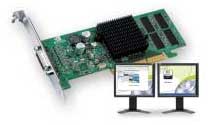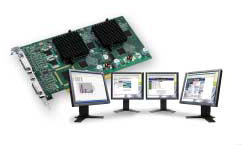| While it's once every
six months that NVIDIA graces the desktop world with a new graphics part,
annually the professional world gets a dose of a new Quadro part. NVIDIA
originally introduced the Quadro line with the release of their GeForce
256 GPU, although back then the Quadro GPU was nothing more than a higher
clocked version of the GeForce 256 GPU with hardware AA lines support
enabled.
The Quadro line has come a long way since its inception. When it first hit the streets the newcomer caused a bit of an uproar in the market since it was priced significantly lower than the competition while offering significantly higher performance. The biggest blow dealt to the competition was the fact that NVIDIA's Quadro was nothing more than a re-badged GeForce 256 at 3x the price yet still over 50% cheaper than the slower alternatives on the market. The Quadro has brought NVIDIA immense success in the professional graphics market. During our briefing with NVIDIA they recited recent sales numbers placing the Quadro brand as being in over half of the x86 workstations currently on the market. Interestingly enough, the second runner up wasn't ATI or 3DLabs but Matrox. There are still a large number of workstations out there that aren't dependent on high-performance 3D graphics, and thus Matrox is able to survive without having released a significantly redesigned graphics core in almost three years. One aspect of the Quadro's success has brought NVIDIA some grief; many protested the price premium the Quadro carried over the GeForce line by saying that the two chips were basically the same. Others found ways around NVIDIA's chipid scheme to effectively make GeForce based cards look, act and perform like Quadros. And finally there were those that saw what the Quadro offered and simply said no; for the first time a gamer's 3D card was actually used in quite a few budget 3D workstations as the GeForce line became just as much of a professional tool as a gamer's ally. Just weeks after the spectacular launch of their GeForce4 and not so attractive GeForce4 MX series, NVIDIA has high hopes for their fourth generation Quadro series. The newly announced Quadro4 hopes to address the issues we just outlined; from loosening Matrox's grip on the x86 workstation market to better differentiating the Quadro and GeForce brands the Quadro4 attempts to do it all. |
Just an expensive GeForce4?One fact about the Quadro4 that NVIDIA is very proud of is that for the first time since the Quadro was introduced, it is actually a physically different piece of a silicon from its desktop counterpart. In the past, the features that set the Quadro apart from the GeForce were present on both GPUs; they were simply disabled on the GeForce GPU. The most widely known feature that was disabled on the GeForce line of GPUs was support for hardware anti-aliased lines, thus making the original GeForce perform even worse than a TNT2 with AA lines enabled. The base feature set of the Quadro4 is identical to that of the GeForce4 or GeForce4 MX depending on which model of the Quadro4 you're looking at (we'll get to that later). Currently there are only a handful of features that separate the Quadro4 from the desktop GeForce4/MX line however with future generations of the Quadro you can expect there to be even more features made exclusive to it. Some of the features NVIDIA mentioned being Quadro4 specific included hardware AA lines (with an entirely new AA line engine for the NV25GL based cards), hardware overlay planes, hardware XOR engine, and hardware clip/window ids. Without cards to test we weren't able to gauge the usefulness of any of these exclusive features but we will take a look at them in the future once review samples are made available. As we just alluded to, the GeForce4 derived Quadro4 cards use what is internally known as the NV25GL core; likewise, GeForce4 MX derived cards use the NV17GL core. As we mentioned before, the GL suffix actually indicates a different piece of silicon with a larger transistor count and die size than its desktop counterpart. The Quadro4 line will retain all of the features of its desktop counterparts, including multimonitor support through nView. |
Quadro4 XGL
The Quadro4 XGL line is subdivided into five separate cards: Quadro4 900 XGL The 900 XGL is NVIDIA's flagship Quadro4 offering and although NVIDIA wasn't willing to disclose clock speed information we'd assume that the 900 XGL would have an even higher clock speed than the desktop GeForce4 Ti 4600.
As you can guess the 900 XGL is based off of the GeForce4-derived NV25GL core. Cards will be available with 128MB of either SDR or DDR SDRAM. The 900XGL will also feature dual DVI video output connectors. Quadro4 750 XGL The 750 XGL is simply clocked lower than the 900 XGL while retaining all of the other features of the card. The 750 XGL is targeted specifically at 3DLab's Wildcat 6210 card (since according to NVIDIA, the 900XGL will seriously outperform the Wildcat) and is made available with 128MB of DDR SDRAM. The card features one DVI and one VGA output. Quadro4 700 XGL The 700 XGL is identical to the 750 XGL in clock speed yet it features a 64MB DDR SDRAM memory subsystem instead of the larger 128MB outfit. Quadro4 500/550 XGL Here's where things get a little confusing, the Quadro4 500 XGL and 550 XGL aren't based on the NV25GL core rather they use the NV17GL core. This means that these two cards are GeForce4 MX derivatives, meaning that they definitely won't be as great of performers as the 700+ series Quadro4 cards. The 550 XGL features 64MB of DDR SDRAM while the 500 XGL is a SDR part. Only users with cards slower than last year's Quadro DCC should consider the Quadro4 500/550 XGL. |
Quadro4 NVS: Targeting Matrox
Take the financial market for example; at the top financial analyst firms it is commonplace to have more than two monitors at a desktop workstation, and until recently neither ATI nor NVIDIA's multimonitor solutions would support more than 2 CRT/LCD displays. The introduction of NVIDIA's nView changes that as the name implies that it supports up to n-displays. The Quadro4 NVS line is targeted squarely at Matrox's market share and it does so with two distinct products - the 200 NVS and the 400 NVS. Although the Quadro4 NVS GPU is based off of the NV17GL chip, the cards are not certified for use in any 3D applications. NVIDIA's reasoning behind this is that these markets aren't concerned with 3D performance and the NVS line will have particularly poor 3D performance (much like the Matrox cards they're up against). This leads us to believe that the core/memory clocks of the NVS lines will be noticeably lower than that of the GeForce4 MX desktop lines, potentially even lower than the GeForce4 MX 420.
The Quadro4 200 NVS is an AGP solution with a 128-bit SDR SDRAM bus much like the GeForce4 MX 420. This part features a single 60-pin output connector known as a Low Force Helix (LFH). Dongles will be made available that can split this single connector into dual DVI or dual VGA ports. The LFH connector will also be found on the Quadro4 500/550 XGL as well as the Quadro4 400 NVS. The 400 NVS is aimed directly at a niche market controlled almost entirely by Matrox at this point - the > 2-monitor display market. Matrox currently ships a version of their old G200 known as the G200 Multi-Monitor Series (MMS) with support for up to 4 displays. As you can probably guess, a single 400 NVS card can support up to 4 displays as well through the use of two LFH connectors for maximum flexibility in terms of VGA/DVI combinations.
NVIDIA enabled support for 4 displays by placing two NV17GL chips on the 400 NVS' PCB. Although all NVIDIA chips since the NV20 have an integrated AGP bridge NVIDIA has still not worked out all the kinks with bringing a multi-chip AGP solution to market and thus the 400 NVS remains a PCI card. Without any need for 3D performance the PCI bus does just fine for normal graphics and it provides an interesting expansion capability across the bus; users are able to use multiple 400 NVS cards to support up to 32 displays. The 400 NVS is outfitted with a 64-bit DDR memory bus and is again, not certified for any professional 3D applications. That doesn't mean it won't work under them, it just means that the performance is low enough that NVIDIA would rather you not use it as a 3D card. The final point to make about the NVS line is that although the cards are all derived off of a platform similar to the GeForce4 MX, nView has been improved a bit allowing for more desktops and hotkeys. |
Final WordsSince this is just a preview we can't give you much of a conclusion but there are some interesting things NVIDIA is trying with the Quadro4 that we'd like to address. First and foremost, although the Quadro4 is largely the same as the GeForce4 it's clear that NVIDIA wants to distance its professional brand from its desktop name. What this means is that going forward we will begin to see many more workstation-specific features implemented in the GL parts that would have normally not been considered because of die space constraints on the desktop side. Pricing continues to be a huge win for NVIDIA when compared to their chief perceived competition in the professional 3D market. Competing cards from 3DLabs are priced in the thousands while even the Quadro4 900 XGL is priced at roughly 50% of the top of the line Wildcat. From what NVIDIA is claiming they will continue to offer higher performance even at these lower price points. With continued pressure from NVIDIA, 3DLabs may be forced to either speed up development of their parts or think about dropping prices. While there are still some areas where 3DLabs cards hold advantages over the Quadro line (for example, in subpixel precision which is useful in determining rendering accuracy), with every year that goes by NVIDIA's Quadro line becomes even more workstation specific and thus even more competitive. NVIDIA's naming debacle continues even in the Quadro world with the difference between the NV17GL based Quadro4 500 and the NV25GL based Quadro4 700 being downplayed by the slight difference in product names. Luckily the lack of programmable pixel shader support in the Quadro4 500/550 XGL isn't as disappointing as it is on the desktop side. This is the first time since NVIDIA started building up steam in the graphics market that they have singled out a market that Matrox has dominated in. Matrox has in the past been driven from the desktop graphics market segment and thus found a comfortable home in supplying the 2D workstation, business and video editing markets. With the Quadro4 NVS line being priced virtually on par with Matrox's G450/G200 MMS cards it won't be smooth sailing for Matrox any longer. It's amazing that Matrox has been able to sustain this long on the same 3-year old graphics architecture that they introduced with the G400, but with NVIDIA actively pursuing some of their core markets it's time for Matrox to get back in the game otherwise they may see that market share slip away. We'll provide you with a more thorough look at the performance of the Quadro4 and how it stacks up to the competition in a forthcoming professional graphics card roundup but for now we hope this introductory preview will suffice. NVIDIA is definitely spicing things up in the workstation market and it seems like they have every intention to dominate in that market much like they do in the desktop world. |
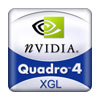 As was NVIDIA's goal with the GeForce4 launch, the
Quadro4 line will be made available in both entry-level (Quadro4 NVS) and
main-stream/performance (Quadro4 XGL) models.
As was NVIDIA's goal with the GeForce4 launch, the
Quadro4 line will be made available in both entry-level (Quadro4 NVS) and
main-stream/performance (Quadro4 XGL) models. 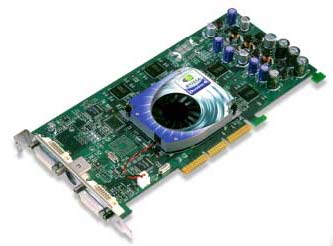
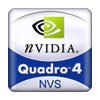 At the very start of this preview we mentioned that
the second largest share of the x86 workstation graphics market belongs to
none other than Matrox. Matrox has been able to acquire a strong foothold
in this market and stay there for so long because of the fact that there
is still a large percentage of the workstation market that does not depend
on lightning fast 3D acceleration. This market segment is more interested
in 2D image quality, multi-monitor support, and other such features that
have nothing to do with how many pixel or vertex shader pipelines you
have.
At the very start of this preview we mentioned that
the second largest share of the x86 workstation graphics market belongs to
none other than Matrox. Matrox has been able to acquire a strong foothold
in this market and stay there for so long because of the fact that there
is still a large percentage of the workstation market that does not depend
on lightning fast 3D acceleration. This market segment is more interested
in 2D image quality, multi-monitor support, and other such features that
have nothing to do with how many pixel or vertex shader pipelines you
have.